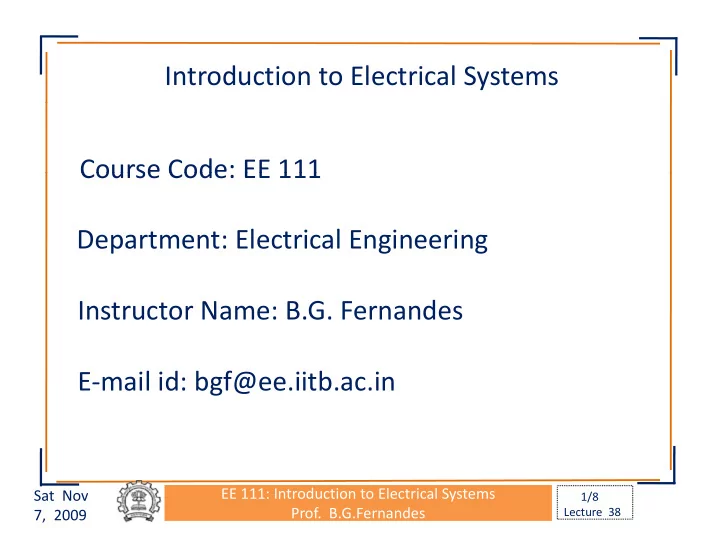

Introduction to Electrical Systems Course Code: EE 111 Course Code: EE 111 Department: Electrical Engineering Department: Electrical Engineering Instructor Name: B G Fernandes Instructor Name: B.G. Fernandes E ‐ mail id: bgf@ee iitb ac in E ‐ mail id: bgf@ee.iitb.ac.in EE 111: Introduction to Electrical Systems Sat Nov 1/8 Prof. B.G.Fernandes Lecture 38 7, 2009
Sub ‐ Topics: • Classification of dc machines • Performance characteristics EE 111: Introduction to Electrical Systems Sat Nov 2/8 Prof. B.G.Fernandes Lecture 38 7, 2009
Review ⇒ speed of F s = 0 & there is saliency ⇒ speed of F = 0 & there is saliency ⇒ ‘V’ induced in armature conductor is ac ⇒ commutator + brushes convert ac to dc t t b h t t d → mechanical rectifier ⇒ brushes are fitted to the stator, mounted on the b h fitt d t th t t t d th commutator ⇒ direction of current in all the armature ⇒ direction of current in all the armature conductors on one side of pole is the same & armature mmf axis is fixed → it is always at 90 0 w.r.t. field axis. ∠ = ∠ = F o o 90 or δ 90 or δ 90 90 r F F s EE 111: Introduction to Electrical Systems Sat Nov 3/8 Prof. B.G.Fernandes Lecture 38 7, 2009
⇒ unlike other machines(IM & syn.), in dc machine, ‘ δ ’ does not change with load δ does not change with load ⇒ if ‘F’ s is held constant, ‘F’ r (i a ) will change 90 0 F (I ) & F (I )can be changed independently ∵ δ ∵ δ = 90 0 , F S (I F ) & F r (I a )can be changed independently (more later) ∵ brushes are in contact with commutator ∵ brushes are in contact with commutator wear/tear, regular maintenance ⇒ may not be suitable for high speed application y g p pp (arcing may take place) ⇒ E o → open circuit voltage w.r.t. I F for p g o F constant ‘ ω ’ ∴ E α I ∴ E o α I F EE 111: Introduction to Electrical Systems Sat Nov 4/8 Prof. B.G.Fernandes Lecture 38 7, 2009
⇒ due to armature reaction air gap flux reduces. stator eq. ckt: ⇒ at steady state, V F = R F I F rotor eq. ckt: rotor eq. ckt: ⇒ Induced emf in armature, E = K φ ω K φ E EE 111: Introduction to Electrical Systems Sat Nov 5/8 Prof. B.G.Fernandes Lecture 38 7, 2009
classification of dc machines: separately excited dc generator(S.E): separately excited dc generator(S E) ⇒ field is connected to a separate dc source source 2 v = F P F R F F ⇒ for given V F , P F ↓ as R F ↑ → use thin conductor & there would be large no of turns → use thin conductor & there would be large no. of turns external characteristics: → variation of V with I at constant ω → variation of V t with I L at constant ω = − = V E I R I I t a a a L = E E K φ K φω EE 111: Introduction to Electrical Systems Sat Nov 6/8 Prof. B.G.Fernandes Lecture 38 7, 2009
• as I a ↑ , ‘ φ ’ due to I a also ↑ & due to armature reaction, due to armature reaction, air gap flux ↓ → E α (air gap flux) ω → E α (air gap flux) ω ⇒ power is developed in the armature, R a comes in the main path of power flow, so it should be small. main path of power flow, so it should be small. ⇒ needs a separate dc source ⇒ instead if there is residual magnetism ⇒ instead if there is residual magnetism → connect the field across the arm. terminals t i l → as the rotor starts rotating → small ‘V’ is induced in the armature ll ‘V’ i i d d i h EE 111: Introduction to Electrical Systems Sat Nov 7/8 Prof. B.G.Fernandes Lecture 38 7, 2009
→ this ‘V’ drive a small ‘I’ in the field v v r Δ ≅ i + F R R a F → this Δ i flows in N (field winding) → this Δ i F flows in N F (field winding) → generates its own flux → this φ can either aid or oppose the residual flux thi φ ith id th id l fl → if it aids, then there is ↑ in air gap flux → this ↑ the ‘V’ induced in the armature & ∴ Δ i F hi ↑ h ‘V’ i d Δ i d i h & → ‘V’ builds up & attain a steady value → m/c develops ‘V’ at its own & it is due to residual magnetism → hence the name self excited dc generator h h lf d d EE 111: Introduction to Electrical Systems Sat Nov 8/8 Prof. B.G.Fernandes Lecture 38 7, 2009
Recommend
More recommend